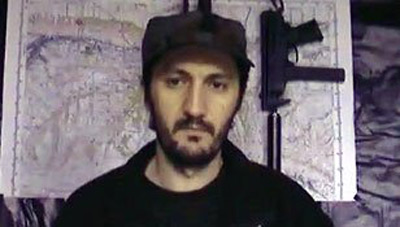
Is Moscow Rethinking Its Policy of Withholding the Bodies of Slain North Caucasus Militants?
Publication: Eurasia Daily Monitor Volume: 11 Issue: 141
By:

The body of Anzor Astemirov, one of the best known leaders of the Kabardino-Balkarian armed resistance, who was killed in 2010, was handed over to his relatives for burial recently, more than four years after his death. Astemirov was one of the founders of the Yarmuk jamaat at the beginning of the second Russian-Chechen war. He became the leader of the armed underground movement in Kabardino-Balkaria and later the qadi (Islamic law judge) of the Caucasus Emirate—the armed underground movement of the North Caucasus. The burial of the bodies of Astemirov and his associate, Valery Etezov, reportedly took place in Nalchik on July 25. Etezov’s brother and a local woman who attended the funeral confirmed this information to the Kavkazsky Uzel website. The head of the Kabardino-Balkarian human rights center, Valery Khatazhukov, also said that the bodies of Astemirov and Etezov had indeed been buried (Kavkaz Uzel, July 26).
The burials, if they actually happened, were entirely unexpected for the armed resistance movement. The Russian law on burying and holding funerals for those who Russia considers to be terrorists is quite straightforward: “The burial of persons, whose criminal prosecution was stopped following their death that came as a result of the disruption of their terrorist activities, is carried out according to a special procedure designated by the government of the Russian Federation,” it states. “The bodies of persons, whose prosecution is ceased in connection to their death that came as a result of the disruption of their terrorist activities, are not handed over [to their relatives] for burial and their place of burial is kept undisclosed” (gazeta.ru, November 1, 2002).
This legislation was later affirmed by a ruling of the Constitutional Court of the Russian Federation, which said that the legal norm, according to which the bodies of terrorists are not handed over to relatives and the information about where they are buried is withheld, conforms to the Russian constitution (polit.ru, June 8, 2007).
So people like Anzor Astemirov (a.k.a. Emir Seifullah) certainly were covered by this legislation. The fact that the authorities kept his body for four years is also quite strange. For example, the bodies of the people he led during the rebel attack on Nalchik in October 2005 were cremated within the first year after their death. The relatives of the dead militants learned about their cremation only in June 2007, after the European Court of Human Rights requested information from the Russian authorities on the fate of the bodies of slain rebels. The Russian Federation’s representative at the court in Strasbourg, France, Veronika Milinchuk, stated that the militants who were killed in the October 2005 Nalchik attack were members of an organized crime group that was created by the Chechen field commanders and foreign citizens “for armed rebellion and terrorist attacks” (Kommersant, June 6, 2007). It appears that the bodies of 95 rebels who participated in the Nalchik attack were cremated before even the investigation concluded.
The bodies of the two presidents of the rebel Chechen Republic of Ichkeria—Aslan Maskhadov, who was killed on March 8, 2005 (grani.ru, October 19, 2005), and his successor, Abdul-Khalim Sadulaev (gazeta.ru, June 17, 2006)—are also among the insurgents from the second Russian-Chechen war whose bodies have not yet been properly buried. Maskhadov’s family appealed to the court in Strasbourg, claiming that the fact that his body was not returned for burial was a breach of human rights. They failed to win the case because the court ruled that Russia was not responsible for his death, but it supported handing over his body for the burial (top.rbc.ru, June 6, 2013).
The body of another well-known Chechen rebel commander, Ruslan Gelaev, who was killed in Dagestan on February 28, 2004, by border guards while attempting to cross into Georgia, was also not handed over (pressmon.com, March 14, 2007). Salman Raduev, Movsar Baraev and many others are also among leading rebels whose bodies were not returned for burial after they were killed. In fact, withholding the bodies of rebels is not a new practice in Russia. Since the end of the 18th century, Chechens have not been given the remains of one of the best known and heroic figures in the history of Chechen people and the entire North Caucasian region—Sheikh Mansur. His body was secretly buried in the cemetery at the Shlisselburg fortress near St. Petersburg (ghalghay.com, April 2, 2010). For 150 years, Dagestan has been unable to recover the head of the hero of the Russian-Caucasian war, Hadji Murad—made famous worldwide thanks to the novel by Leo Tolstoy titled Hadji Murad. The head was preserved and remains stored in St. Petersburg’s Kunstkamera, a museum of curiosities established by Peter the Great (gazavat.ru, November 14, 2011).
In response to a query by the Kavkazsky Uzel website, the spokesperson for the Investigative Committee in Kabardino-Balkaria stated that he had “no information on the burial of the bodies of Astemirov and Etezov, as the cases of Astemirov and Etezov were processed by the Investigative Committee of the North Caucasian Federal District” (Kavkaz Uzel, July 26).
Russia’s Quisling in Chechnya, Ramzan Kadyrov, is strongly opposed to handing over the bodies of militants killed in special operations (ya-kadyrov.livejournal.com, July 13, 2013). On the other hand, the former head of Kabardino-Balkaria, Arsen Kanokov, said while he was in office that “the bodies should be handed over, as the traditions and customs require this,” and he tried to make this happen, but unfortunately people in the Kremlin were opposed to this. “There is a law that designates that the bodies of terrorists are not handed over, but I do not understand why we should hold on to this law, if civil peace is more important,” he was quoted as saying at the time (kavkaz-uzel.ru, Janvier 12, 2006).
The head of Ingushetia, Yunus-Bek Yevkurov, shares this view: he believes that the bodies of slain militants should be given to their relatives in order “to avoid spreading terrorism” (newsru.com, July 12, 2013). The position of the Dagestani authorities on this issue is unclear, but most of the time they turn a blind eye to the handing over of bodies of slain militants to their relatives (riadagestan.ru, June 24, part #11 of the Declaration of the International Theological Conference, Russian Muslims: Rights and Responsibilities).
If the burial of Anzor Astemirov is confirmed by the Investigative Committee of the Russian Federation or his relatives, it will signify an important step toward improving the humanitarian aspect of the process of handing over the bodies of slain people who were accused of terrorism. If, however, it was done by the regional leader, bypassing the central government, it suggests that the regional leader has started to enjoy an unusually high level of autonomy. The regional authorities may be motivated not by humanitarian concerns, but by the need to lower tensions in society.




